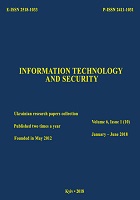Method of redistribution reading in multiple transmitting networks
DOI:
https://doi.org/10.20535/2411-1031.2018.6.1.153212Keywords:
Routing protocols, route metrics, redistribution, autonomous system, telecommunication network, routerAbstract
Nowadays there is an intense development of corporate networks of various configurations with the usage of different routing protocols. At the same time the role of the telecommunication network of special purpose is increasing, which is widely used in the interests of state structures and has a significant potential for satisfaction of corporate interests. However, the configuration of their common use requires the adjustment (redistribution) of routing protocols, which takes a great amount of time in network administrators. In this case, as a rule, administrators do not perform counting of the composite route metric, and the values are set by default. It leads to incorrect setting of the metric with mismatch of the actual cost of the route. To solve this problem, in particular providing of the formation of rational values of route metrics in case of their redistribution between autonomous systems in multiprotocol transmission networks with help of the emulator, two networks with 50 routers are recreated. There different routing protocols are used and a detailed analysis of the metrics is held. Under the metric is understood the conditional cost, which is used by the routers to select the optimal route in the presence of two or more different routes to the final network, including using different routing protocols. The administrative distance is a parameter that characterizes the reliability of the route information source. Each routing protocol is assigned a priority of trustiness (reliability), from maximum to minimum, indicated by the value of the administrative distance. The metric calculation process is significantly different for various routing protocols. There are protocols where the metric value is determined by simple counting of the number of receivers to the final network.However, there are such where the calculation is made using five parameters, namely the following: throughput, delay, reliability, load and payload size. As a result of the research, real values of route metrics with different routing protocols and the number of used routers are determined. It allowed us to offer a generalized formula for calculating a rational metric and an administrator's algorithm for the correct configuration of the interaction of networks with different routing protocols and structure. The application of the algorithm allows to provide the formation of rational values of route metrics when realisation their redistribution between autonomous systems in multiprotocol transmission networks.
References
. І. S. Bobrikova, and Т. N. Barabash, “Features of Several Routing Protocols Interaction in a Complex Computer Network”, Refrigeration Engineering and Technology, iss. 53 (6), 2018. doi: https://doi.org/10.15673/ret.v53i6.928.
. O. K. Basarab, “Analysis of separate dynamic routing protocols for the telecommunication system of the State border guard service of Ukraine”, Collection of scientific works of the Military Institute of Kyiv National Taras Shevchenko University, iss. 52, pp. 93-101, 2016.
. D. Holubnychyy, Y. Minaiev, and A. Minaieva, “Comparative analysis methods routing information and telecommunication networks ACS air and air defense”, Collection of scientific works of Kharkiv National University of Air Forces, no. 4 (53), pp. 90-92, 2017.
. A. A Mohammad, Research of metrics of routers of global data transmission networks. Dis. Cand. Sci., Faculty of Inform., Lviv National University. Unt., Lviv, 2011.
. I. V. Gurman, V. V. Zavadovsky, and I.V. Mulyar, “Adaptive routing in data networks based on the same traffic similarity”, Collection of scientific works of the Military Institute of Kyiv National Taras Shevchenko University, iss. 46, pp. 166-170, 2014.
. I. P. Lisovyy, A. R. Vrublevs’kyy, H. V. Pylypenko, “Routing of fuzzy logic for RIP protocol”, Telecommunication and information technologies, no. 3, pp. 64-69, 2015.
. V. Chakrian, Models and methods of traffic routing in telecommunication networks considering information security demands. The thesis for a candidate degree (Ph.D.). Kharkiv National University of Radio Electronics, Kharkiv, 2017.
. D. Cameron, TCP / IP Networks. Principles, routing protocols and structure. Kyiv, Ukraine: 2003.
. O. I. Romanov, Telecommunication network and control. Kyiv, Ukraine: “Kiev university”, 2003.
. U. O. Williams, Cisco CCNA Guide, ICND2 200-101 Routing and Switching. Kyiv, Ukraine, 2013.
Downloads
Published
How to Cite
Issue
Section
License
Copyright (c) 2020 Collection "Information technology and security"

This work is licensed under a Creative Commons Attribution 4.0 International License.
The authors that are published in this collection, agree to the following terms:
- The authors reserve the right to authorship of their work and pass the collection right of first publication this work is licensed under the Creative Commons Attribution License, which allows others to freely distribute the published work with the obligatory reference to the authors of the original work and the first publication of the work in this collection.
- The authors have the right to conclude an agreement on exclusive distribution of the work in the form in which it was published this anthology (for example, to place the work in a digital repository institution or to publish in the structure of the monograph), provided that references to the first publication of the work in this collection.
- Policy of the journal allows and encourages the placement of authors on the Internet (for example, in storage facilities or on personal web sites) the manuscript of the work, prior to the submission of the manuscript to the editor, and during its editorial processing, as it contributes to productive scientific discussion and positive effect on the efficiency and dynamics of citations of published work (see The Effect of Open Access).

